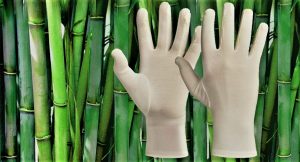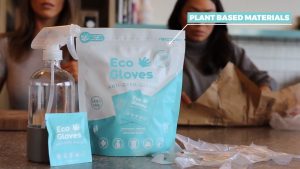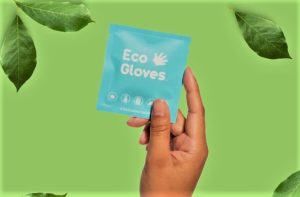A growing number of people today are concerned about the effects of their daily activities on the natural world. Many consumers are therefore looking for options that are more friendly to the planet and its inhabitants. The use of environmentally Eco friendly gloves has seen a rise in demand in recent years.
This article will introduce the topic of Eco-friendly gloves, discussing their definition, the materials used to produce them, the benefits they provide, and the varieties currently on the market.
Gloves have numerous applications outside of the medical field and in the food service and manufacturing sectors. Traditional gloves made from synthetic materials like nitrile and vinyl can take centuries to decompose in landfills, despite their important role in preventing the spread of germs and protecting people from harmful substances.
The gloves we wear every day, and the gloves we use to protect ourselves from the elements, are often made using chemicals that are harmful to humans and the environment.
Materials Used in Eco Friendly Gloves
Eco friendly gloves are made from various materials that are better for the planet than conventional gloves, typically made from leather and harmful synthetic materials. The following are examples of such resources:

1. Natural Latex
Rubber tree sap is processed to create natural latex. It’s commonly used to make eco friendly gloves because it’s long-lasting and biodegradable. Additionally, natural latex gloves are soft, long-lasting, and offer great resistance to bacteria and chemicals.
2. Bamboo
Eco friendly gloves are often made from sustainable materials like cotton and bamboo. Bamboo is a great alternative to conventional materials like cotton because it can be grown rapidly without the use of pesticides or fertilizers.
In addition to being a great option for people with sensitive skin, medical professionals can also benefit from wearing gloves made from bamboo because of their lightweight, breathable, and antimicrobial properties.
3. Recycled Materials
Recycled materials such as plastic bottles, rubber tires, and other post-consumer waste are used to make some eco friendly gloves. These gloves are a great example of upcycling, taking materials that would otherwise be thrown away and giving them a new purpose.
4. Biodegradable Materials
Biodegradable materials refer to ones that can break down naturally. Cellulose, cornstarch, and plant-based plastics are just a few examples of biodegradable materials used to manufacture eco friendly gloves. These materials decompose much more rapidly in natural settings, lessening their impact on landfills and reducing the need for nonrenewable resources.
Benefits of Eco Friendly Gloves
There are some advantages to using eco friendly gloves, both for the environment and for the users themselves. The use of environmentally friendly gloves has many advantages.

1. Reducing Environmental Impact
Sustainable materials and production methods are used to create eco friendly gloves, lowering their environmental impact. In addition to protecting wildlife, this also helps lower pollution levels and preserve precious resources.
2. Cost-Effective
You can save money by buying eco friendly gloves in bulk. Because of this, they are a great choice for companies that want to lessen their financial and ecological footprints.
3. Reducing Waste
Thanks to recycled or biodegradable materials, many eco friendly gloves are now available on the market. This helps to cut down on the number of gloves that wind up in landfills.
4. Relaxation and Effectiveness
Unlike their synthetic counterparts, gloves crafted from sustainable materials like bamboo and natural latex are not only kind to the environment but also offer superior comfort and control. This makes them a great option for people who need to wear gloves for long periods of time, such as healthcare workers.
Types of Eco Friendly Gloves
As sustainability becomes an increasingly important concern, the demand for eco friendly products continues to grow, including gloves.
These gloves are designed to offer the necessary protection to the wearer while minimizing their impact on the environment. This section will explore the various types of eco friendly gloves available and their unique benefits.

1. Biodegradable gloves
One type of eco friendly glove is biodegradable gloves, which are made from plant-based materials that break down naturally in the environment. Biodegradable gloves provide an excellent alternative to traditional disposable gloves, which can take hundreds of years to decompose in landfills.
2. Recyclable gloves
Another option is recyclable gloves, which are made from materials like recycled rubber, polyester, or nylon that can be recycled into new products after use. Using recyclable gloves can help reduce waste and conserve resources.
3. Reusable Gloves
Reusable gloves are ideal for industries that require frequent glove changes. They are made from durable materials like silicone or rubber and are designed to be washed and reused multiple times, reducing the need for disposable gloves.
4. Compostable Gloves
Finally, compostable gloves are another type of eco friendly glove. These gloves are made from materials that break down in composting conditions and are an excellent alternative to traditional disposable gloves for the food service industry, where gloves are frequently used and discarded.
By using eco friendly gloves, businesses can reduce their environmental impact while still ensuring the safety and protection of their employees. At this point, we can find two major categories of eco friendly gloves: disposable and work gloves.
5. Disposable Gloves
Disposable gloves are used in various industries, including healthcare, food service, and cleaning. Eco friendly disposable gloves are available in various materials like natural latex, bamboo, and biodegradable materials like cornstarch.
6. Work Gloves
Eco friendly work gloves are another popular type of eco friendly gloves. Work gloves are essential for those who work in construction, agriculture, manufacturing, and other industries that require manual labor.
Traditional work gloves are often made from synthetic materials like polyurethane or neoprene, which are not biodegradable and can harm the environment.
However, eco friendly work gloves are now available that are made from sustainable and biodegradable materials, making them a much better choice for the environment. Some examples of eco friendly work glove materials include:
- Natural rubber: Natural rubber is a sustainable and biodegradable material that can be used to make eco friendly work gloves. Rubber gloves are flexible, durable, and can stand up to various environmental conditions, making them a great choice for those who work outdoors.
- Bamboo: Bamboo is a fast-growing and sustainable material that can be used to make eco friendly work gloves. Bamboo gloves are lightweight, breathable, and comfortable, making them a popular choice for those who work in hot or humid conditions.
- Recycled plastic: Some companies produce work gloves made from recycled plastic materials like PET bottles. This helps reduce waste and creates a durable and comfortable glove that can stand up to heavy use.
- Cork: Cork is a renewable and biodegradable material that can be used to make eco friendly work gloves. Cork gloves are lightweight, flexible, and durable, making them a great choice for those who need to handle tools or other equipment.
In addition to being made from sustainable materials, eco friendly work gloves also offer many of the same benefits as traditional work gloves. They can protect your hands from cuts, abrasions, and punctures and provide a secure grip to help prevent accidents.
Plus, because they are made from natural materials, they are less likely to cause skin irritation or allergic reactions.
Some popular brands of eco friendly work gloves include Bionic, West County Gardener, and Wells Lamont. These gloves are made from a range of sustainable materials and offer different levels of protection and durability. You can choose the one that suits your needs the most.
Certification and Standards for Eco Friendly Gloves
The need for eco friendly gloves verified by authoritative bodies is expanding as customers become more ecologically aware. Looking for certificates and standards verifying eco friendly practices is vital when purchasing gloves. Many groups offer certification and standards for environmentally friendly and biodegradable goods, including gloves.
- EPA: The Environmental Protection Agency (EPA) has issued regulations that manufacturers of environmentally friendly gloves must follow. Topics like material sources, production techniques, and waste management are all covered by these rules.
- BPI: Eco friendly gloves can also be verified and certified by the Biodegradable Products Institute (BPI). Gloves with the BPI seal of approval have been proven to be biodegradable and compostable in accordance with strict industry standards.
- FSC: For added environmental credibility, gloves constructed from wood or paper should be Forest Stewardship Council (FSC) certified. Gloves with the FSC label on them have been verified to have been crafted using methods that minimize their impact on the environment, society, and economy.
- ASTM: These certifications are in addition to standards established by groups like the American Society for Testing and Materials (ASTM) and the European Union (EN). In order to guarantee that eco friendly gloves are of adequate quality and safety, these groups devise procedures for testing and evaluating their functionality.
- EPA: Those environmentally friendly gloves can get certification from the Environmental Protection Agency(EPA) as well. Energy efficiency, water savings, and waste reduction are only a few of the environmental topics covered by these certifications.
- GOTS: The Global Organic Textile Standard (GOTS) is another significant certification since it guarantees that organic textiles, such as cotton and others, are grown and handled ecologically soundly. There is a higher likelihood that gloves made from organic materials that have been approved by the Global Organic Textile Standard (GOTS) are devoid of toxic chemicals and manufactured in an eco friendly process.
Factors to Consider When Choosing Eco Friendly Gloves
Many considerations should be made while selecting eco friendly gloves to ensure they serve their purpose well while being kind to the planet. Among these are some of the following:
- Material source and sustainability: Consider where the gloves’ materials came from and whether or not they can be used indefinitely. To lessen your impact on the planet, try using gloves produced from sustainable materials like bamboo or recycled materials.
- Certifications and standards: Seek gloves certified as ecologically friendly by organizations like EPA, FTC, FSC, GOTS, and so forth. We’ve explained these certifications above.
- Biodegradability: Consider whether the gloves are biodegradable or compostable so they do not contribute to the buildup of waste in landfills. It means that the gloves can break down naturally, so they won’t harm nature anytime in the future.
- Performance and durability: Choosing gloves that are good for the environment is vital, but so is picking gloves that work well for their intended purpose and can withstand several washings and uses without breaking down. Durable gloves also save your pocket.
Care and Maintenance of Eco Friendly Gloves
Proper care and maintenance of eco friendly gloves are essential to ensure their longevity and reduce the need for replacements, which can contribute to waste. To keep your gloves in good condition, follow these tips:

- Follow manufacturer instructions: Always refer to the manufacturer’s instructions for cleaning and maintenance, as different materials may require different care.
- Hand wash: Most eco friendly gloves are not suitable for machine washing, so hand washing with mild detergent and warm water is recommended. Avoid using hot water, bleach, or fabric softeners, as these can damage the gloves.
- Air dry: High heat can damage the material, so avoid using a dryer. Instead, air-dry the gloves in a well-ventilated area. Do not hang them in direct sunlight, as this can cause discoloration.
- Store properly: Store gloves in a cool, dry place away from direct sunlight and heat sources to prevent damage. Ensure the gloves are completely dry before storing them, as dampness can lead to mildew and mold growth.
By properly caring for your eco friendly gloves, you can extend their lifespan and minimize waste, contributing to a more sustainable future.
Top Eco Friendly Glove Brands
If you’re in the market for eco friendly gloves, a variety of brands offer options made from sustainable and biodegradable materials. Here are some of the top contenders to consider:

- Ansell: Harnessing the power of natural rubber latex, Ansell provides a range of renewable and biodegradable glove products that you can choose from.
- ATG: Committed to environmental responsibility, ATG offers work gloves made from bamboo and recycled polyester that are both sustainable and effective.
- Eco Gloves: For those needing disposable gloves, Eco Gloves provides a solution with gloves made from plant-based materials like cornstarch and PLA that can be fully composted.
- Showa: From bamboo to recycled polyester, Showa offers a variety of eco friendly gloves that cater to different needs and are made from sustainable materials.
Conclusion
Selecting gloves made from sustainable materials is a significant action toward safeguarding the world. Reducing waste and extending the life of gloves can be accomplished by using sustainable and biodegradable materials and careful maintenance and care. Think about where it came from and whether it has been eco friendly gloves certified. Also, think about how well it performs and how long it lasts.

I am not a good blogger but I started blogging when I was in my college. one day scrolling my social media pages and top of the page one notification was coming like this “ earn money from blogging”.then I clicked that notification. After that, I was confused that which niche is better for me. Finally, I selected the niche and I was comfortable with that glove’s reviewer.

